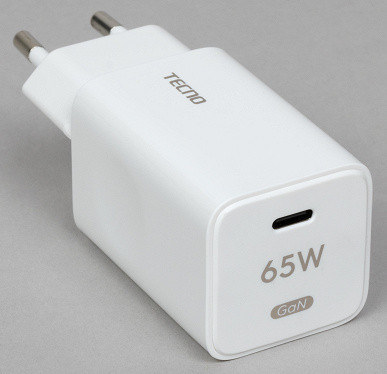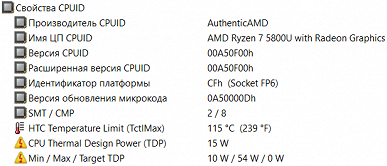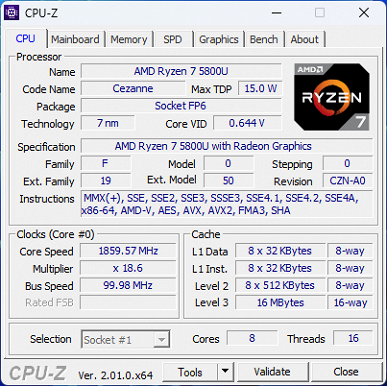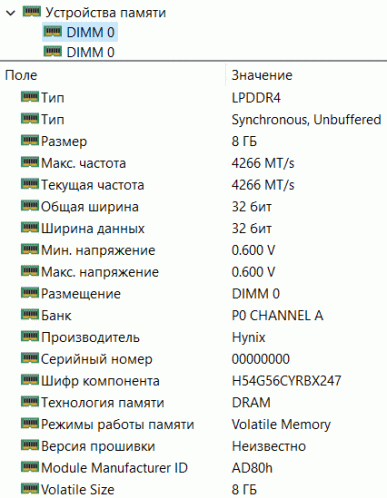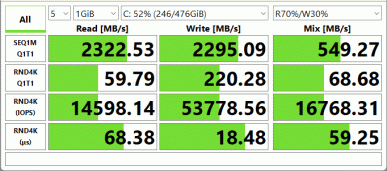We are already familiar with several laptop models from Tecno that are equipped with Intel processors. Now it's time to pay attention to products with AMD processors. Introducing the new Tecno Megabook T15DA, powered by an octa-core AMD Ryzen 7 processor.
Configuration and equipment
The specification looks like this:
| Tecno Megabook T15DA | ||
|---|---|---|
| CPU | AMD Ryzen 7 5800U (8 cores/16 threads, up to 1.9/4.4 GHz, 10-25 W) available with AMD Ryzen 5 5560U | |
| RAM | 16 GB LPDDR4-4266 (Hynix H54G56CYRBX247 chips are soldered on the board) the description mentions an 8 GB option | |
| Video subsystem | integrated, AMD Radeon Graphics (Radeon RX Vega 8) | |
| Screen | 15.6 inches, 1920×1080 (16:9), IPS (CMN N156HCE-EN1), 60 Hz | |
| Sound subsystem | Realtek, 2 speakers | |
| Storage device | SSD 512 GB (Foresee XP1000F512G, M.2 2280, NVMe, PCIe 3.0 x4) there is a free slot for a second drive | |
| Card reader | microSD | |
| Network interfaces | Wired network | No |
| Wireless Wi-Fi network | Intel Wi-Fi 6E AX210D2W (IEEE 802.11ax, 2.4/5.0/6.0 GHz) | |
| Bluetooth | Bluetooth 5.3 | |
| Interfaces and ports | USB | 1 × USB Type-C for charging only 1 × USB 3.1 Type-C supporting data transfer, Power Delivery and graphics output 1 × USB 3.1 Type-A 2 × USB 3.0 Type-A |
| RJ-45 | No | |
| Video outputs | 1 × HDMI 1.4 1 × DisplayPort over USB Type-C | |
| Audio connectors | combined for headset (minijack) | |
| Input Devices | Keyboard | with backlight and digital keypad |
| Touchpad | clickpad | |
| IP telephony | Webcam | 1080p@30 fps, has a mechanical shutter |
| Microphone | yes (2 pcs.) | |
| Fingerprint's scanner | There is | |
| Battery | 70 Wh, lithium-ion | |
| Dimensions | 358×235×17.1 mm (including legs up to 20.8 mm) | |
| Weight without power supply | 1.56 kg | |
| Power adapter | 65 W (supports Power Delivery up to [email protected]), weight 0.17 kg (with cable) | |
| operating system | Windows 11 Home (22H2) |
The SSD capacity is divided into two parts: 200 gigabytes are used for the system partition, and the rest remains free. The laptop comes pre-installed with Windows 11 Home operating system, as well as OneLeap utility, which provides wireless connection to a smartphone in the Tecno ecosystem. It also comes with a suite of Microsoft 365 apps that require payment to use. The product is packaged in a stylish cardboard box with a convenient carrying handle.
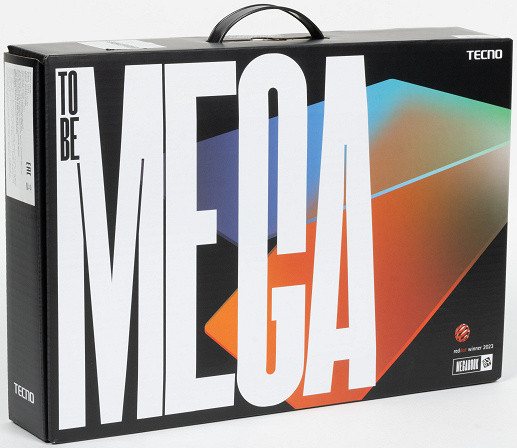
In addition to the laptop itself, the kit includes a power adapter with a replaceable output cable 1.75 m long, an instruction booklet in Russian, and a sheet with certification information.

Appearance and ergonomics
The device is offered in a gray color, officially called Space Grey. The texture of the surfaces is matte with a slight roughness; handprints are visible on them, but not noticeable.

The overall design of the Tecno Megabook T laptops looks elegant, although the open lid can be a little confusing due to the numerous colorful stickers. Both body panels and the top cover are made of aluminum alloy, providing good rigidity. However, they may flex slightly when pressed hard. We didn't notice any squeaks or clicks during testing, although the torsional strength of the LCD screen lid leaves a lot to be desired.
The laptop is compact: its dimensions are 358x235 mm, and the maximum body thickness is 17.1 mm (including the rear leg up to 20.8 mm). The weight is almost 1.6 kg, which is quite significant for such a device, mainly due to the large battery capacity.
The plastic frame around the screen has different widths: 6.9 mm on the sides, 12 mm at the top (a webcam with an indicator, microphones and a light sensor are located here), and 18.3 mm at the bottom until the edge of the lid bends.

On the bottom of the laptop, in addition to the legs (two small ones in front and one almost across the entire width at the back), there is a ventilation grille. Air is drawn through it to cool the components, so it is recommended to avoid placing the laptop on soft surfaces.

On the back of the case there are larger slots through which the ventilation system removes heated air. They are closed with a curve that hides the hinges, but this creates heating at the bottom of the screen. However, during intensive testing, this turned out to be insignificant.

Ventilation slots are closed by the bend of the lid
The lid with the laptop screen opens to an angle of up to 180 degrees, without touching the table with the bottom edge, and is securely fixed in any position, starting from 10-15 degrees. To keep it closed, magnets are used at the front edge of the case.

The force required to open the lid is noticeable, but it can be opened with one hand without having to hold the bottom. For user convenience, there is a small recess in the middle of the front edge of the case, which is easy to pick up with your finger, which makes opening even more convenient. This is more difficult to do in other places.

On the left side of the laptop there are the following elements: a hole for a Kensington lock, a two-color LED indicator (white + orange), a USB Type-C connector for connecting a power adapter (only power is supported, data transfer is not supported), a full-size HDMI port, USB 3.1 Type ports -A, as well as another USB Type-C, which is fully functional.

On the right there is a tiny hole for the Reset button (to press it you will need a thin tool, such as a straightened paper clip), a slot for microSD memory cards, two USB 3.0 Type-A ports and a combined jack for an audio headset minijack.

The range of interface ports on this compact laptop is quite extensive, although not the most modern by standards. However, in this device, interfaces like Thunderbolt 4 will probably not be particularly relevant in the near future.
The keyboard is completely identical to the one we already had in the Tecno Megabook T15AA model: membrane with an island button arrangement and a three-row numeric keypad. The up and down arrow keys are «half» height.

The indents on the sides of the keyboard are small, amounting to 14 mm. Most buttons are a standard size: 16.2 x 15.7 mm, while the function buttons are slightly smaller: 14.7 x 9.2 mm. The width of the Enter and left Shift keys is 36.8 mm, and the right Shift is 46.4 mm. The distance between the edges of buttons in one row and between rows is 2.9 mm.
Typing on this keyboard is quite comfortable, the sounds when pressed are quite quiet. The full key travel is about 1.4-1.5 mm.

The keyboard is equipped with a white backlight with four brightness levels. At the minimum level it is barely noticeable, but at the maximum it provides sufficient brightness. The backlight is controlled by a key combination, but it automatically turns off after 15 seconds of keyboard inactivity — not the most convenient feature, although it cannot be affected. Both the characters on the keys and their edges are highlighted, although to a lesser extent.

The CapsLock button has a tiny white LED built into it to indicate when this mode is activated.
The power button is located in the upper right corner of the case, outside the keyboard, and is slightly recessed to reduce the likelihood of accidental pressing. It is clearly visible on the surface thanks to its excellent texture and shiny chamfer around it.

This button has a built-in fingerprint scanner.
The webcam is capable of providing resolution up to 1080p at 30 fps, and a mechanical shutter is also provided.
The touchpad is quite large, its dimensions are 120x78 mm. The surface is slightly recessed and has a smoother texture than the body panels, which makes finger control more comfortable, but fingerprints are more noticeable. There are no dedicated keys, but the left and right edges of the touchpad can be used as mouse buttons. A special combination of buttons is provided for quick shutdown.

Screen
The laptop uses a 15.6-inch IPS matrix with a resolution of 1920x1080 pixels

The outer surface of the matrix screen has a hard black semi-matte tint with pronounced specularity. There are no special anti-reflective coatings or filters, and there is no air gap. When powered by both mains and battery power and with manual brightness adjustment, the maximum brightness value is 310 cd/m² (measured at the center of the screen against a white background). While avoiding direct sunlight, this brightness allows you to comfortably use the laptop outdoors even on sunny summer days.
| Maximum brightness, cd/m² | Conditions | Readability Score |
|---|---|---|
| Matte, semi-matte and glossy screens without anti-glare coating | ||
| 150 | Direct sunlight (more than 20,000 lux) | unreadable |
| Light shadow (approx. 10,000 lux) | we can barely read | |
| Light shade and sparse clouds (no more than 7500 lux) | work is uncomfortable | |
| 300 | Direct sunlight (more than 20,000 lux) | we can barely read |
| Light shadow (approx. 10,000 lux) | work is uncomfortable | |
| Light shade and sparse clouds (no more than 7500 lux) | work comfortably | |
| 450 | Direct sunlight (more than 20,000 lux) | work is uncomfortable |
| Light shadow (approx. 10,000 lux) | work comfortably | |
| Light shade and sparse clouds (no more than 7500 lux) | work comfortably |
These criteria are very tentative and will likely be revised as data accumulates. Note that some improvement in readability can be achieved if the matrix has transreflective properties, which allows you to see the image in the light even when the backlight is turned off. Also, glossy matrices can sometimes be rotated to reflect a uniformly dark image, which can improve readability in bright sunlight. In rooms with bright artificial lighting (about 500 lux), it is convenient to work with a screen brightness of 50 cd/m² or lower.
If the screen brightness setting is 0%, the brightness is reduced to 15 cd/m². In complete darkness, the screen can be made even darker to a comfortable level.
Automatic brightness adjustment is available using the light sensor, which is located to the right of the front camera. In Auto mode, the screen brightness is automatically adjusted based on the ambient light. By default, in the dark the brightness is reduced to 40 cd/m², in bright office lighting (about 550 lux) the screen brightness is 190 cd/m², and in a very bright environment (for example, a clear day outside without direct sunlight) — 310 cd/m². m². The default settings don't always meet user requirements, so we've made additional adjustments to ensure optimal brightness in different conditions.
If the brightness decreases significantly from the maximum value, backlight modulation may be observed. However, the frequency of this modulation is very high (25 kHz), so it is invisible to the human eye and does not cause unpleasant effects.

This laptop uses an IPS matrix. Microphotographs show a typical IPS subpixel structure (black dots are dust on the camera matrix):

Focusing on the screen surface revealed randomly located surface microdefects responsible for the matte properties:

The grain of these defects is several times smaller than the size of the subpixels (the scale of these two photographs is approximately the same), so focusing on microdefects and the focus “jumping” across subpixels when changing the viewing angle are weakly expressed, which is why there is no “crystalline” effect.
We measured brightness at 25 points on the screen spaced at 1/6th of the screen width and height (screen borders not included). Contrast was calculated as the ratio of the brightness of the fields at the measured points:
| Parameter | Average | Deviation from the average | |
|---|---|---|---|
| min., % | max., % | ||
| Black field brightness | 0.24 cd/m² | −9.9 | 6.3 |
| White field brightness | 300 cd/m² | −6.7 | 5.3 |
| Contrast | 1200:1 | −5.8 | 3.4 |
If you move away from the edges, the uniformity of all three parameters is quite good. The contrast, by modern standards for this type of matrix, is slightly above average. It is visually noticeable that the black field is mainly lightened a little closer to the edges. However, the uneven illumination of the black field is visible only in very dark scenes and in almost complete darkness, which is not a significant drawback.
The screen cover is not very rigid and may deform slightly under slight pressure, which may change the black field illumination characteristics. However, without external influences, everything returns to normal.
The screen has good viewing angles without significant loss of brightness or color changes, even at large tilt angles. However, if it deviates diagonally, the black field may become lighter and acquire a yellowish or red-violet tint.
The response time from black to white and back is 25 ms (14 ms on + 11 ms off), and the transition between halftones of gray takes an average of 34 ms. The matrix is quite slow, without overclocking.
The total output latency, from switching the video buffer page to displaying the image on the screen, at a refresh rate of 60 Hz is 11 ms. This delay is negligible and practically unnoticeable when using a PC.
The screen settings offer only one refresh rate — 60 Hz. The image is output at a color depth of 8 bits per color.
We also measured the brightness of 256 shades of gray from 0 to 255. Below is a graph of the change in brightness between adjacent shades:

The increase in brightness across most of the gray scale is generally uniform, with each subsequent hue brighter than the previous one. In the darkest area, all shades are distinguishable both hardware and visually.

The approximation of the resulting gamma curve gave a value of 2.22, which is close to the standard value of 2.2. In this case, the real gamma curve deviates slightly from the approximating power function:

Wider color gamut than sRGB (99.2% coverage and 123.5% volume)

Below is the spectrum for the white field (white line), superimposed on the spectra of the red, green and blue fields (lines of the corresponding colors):

Apparently this screen uses blue-emitting LEDs with green and red phosphors (usually a blue emitter and a yellow phosphor), which provides good component separation. It's also possible that the red phosphor (or green phosphor) uses quantum dots. This fact allows you to obtain a wide color gamut.
The screen does not have a built-in profile with sRGB color gamut. However, on wide-gamut screens, images optimized for sRGB devices may appear unnaturally saturated without appropriate color correction. However, this problem can be solved by using a color management system such as a color profile created using DisplayCAL software.
The grayscale balance is a compromise due to the high color temperature, but the deviation from the blackbody spectrum (ΔE) remains below 2, which is considered excellent. In addition, color temperature and ΔE change little from hue to hue, which has a positive effect on the visual assessment of color balance.
Summarizing the characteristics of the screen of this laptop, we can note its high maximum brightness (310 cd/m²), which allows you to use the device even in bright sunlight, provided it is protected from direct rays. In complete darkness, the brightness can be comfortably reduced to 15 cd/m². Among the advantages of the screen, it is worth highlighting automatic brightness adjustment, low output latency (11 ms) and no flicker. However, it is worth noting some instability of black color when the gaze deviates from perpendicular to the screen. Overall, the screen quality is rated as quite high.
Sound
The audio system, dubbed Tecno VOC by the manufacturer, promises cutting-edge technology in the audio space with support for DTS:X Ultra surround sound. However, in our experience we did not notice anything outstanding: the sound when listening to music, watching movies and playing games was quite good, but within the range of what is expected for compact laptops. The playback volume is subjectively above average and sufficient for individual use.
The speakers are located on the left and right sides of the underside of the case, closer to the front edge, and are directed downwards, which suggests that sound is reflected from the surface on which the laptop is installed.
Battery operation
The declared battery capacity is 70 Wh, the same value is indicated on it, which is confirmed by utilities.

Let's compare it with the autonomy of the already well-known Tecno Megabook T14TA model, which has a slightly larger battery capacity. For testing, we set the screen brightness to 100 cd/m² (roughly 42% of maximum brightness) to eliminate the benefit of devices with dimmer screens. The keyboard backlight is disabled and cannot be activated during testing.
| Load scenario | Operating time, discharge from 100% to 1% |
|---|---|
| Working with text (keyboard backlight off) | 18 hours 29 minutes |
| Watch video | 11 hours 17 minutes |
In absolute numbers, autonomy when working with text is excellent; with video, the situation is worse, but only relative to the result for text.
Now let's compare it with similar class laptops (including other Tecno models) with similar battery capacity.

When working with text, this laptop, although it does not reach the results of the record holder Megabook T14TA, still takes second place unconditionally. Video review also shows the new model to be in the top three.
Regarding mains power: the adapter included in the kit or any charger that supports the 20-volt Power Delivery mode at a current of at least 3 A provides the device with a long-term consumption of three amperes and slightly higher. You can connect to any of the two Type-C connectors, but it is preferable to use the far one, leaving the near one for data exchange.
The standard single-output Type-C adapter is common on Tecno laptops, but uses gallium nitride (GaN) semiconductors, making it lighter and more compact, although still not quite pocket-sized: the case measures 50.5 x 34 x 34 mm, and with a fork — 89 mm.
As mentioned earlier, the kit comes with a 1.75 meter cable with USB Type-C connectors.
This power supply supports PD modes up to [email protected], which is equivalent to 65W. Of course, it can also be used for other devices that support Power Delivery technology.
In previous reviews, we have already compared this unit with an adapter of similar power without GaN technology from the Honor laptop set. In short: Tecno's power supply is noticeably more compact, although Honor's is also not gigantic in size. In terms of weight (rounded values taking into account cables of the same length), the difference is as follows: 170 grams for the Tecno adapter and 200 grams for Honor.
A sticker on the top of the T15DA notebook states that the GaN power supply is «40% smaller» (the website even says 50%); if this refers to the size of the case, then this is close to the truth.

And «40% faster» obviously refers to charging speed, and it's likely just an advertising claim: charging speed depends on current, not semiconductor technology. The maximum currents for Tecno and Honor chargers are the same, determined by the Power Delivery specification, and in both cases they are 3.25 A for 20-volt mode.
We start charging from a standard power supply after automatic shutdown at 1% charge. At the time of charging, the laptop had an installed operating system. The table shows the readings of the corresponding tools of the Windows operating system:
| Charge level | 20% | 40% | 50% | 60% | 70% | 80% | 90% | 95% | 100% |
|---|---|---|---|---|---|---|---|---|---|
| Time, h:mm | 0:28 | 1:06 | 1:27 | 1:46 | 2:03 | 2:22 | 2:46 | 3:12 | 4:28 |
According to these indications, the process is not very fast even for a battery of such capacity: 70% were obtained in two hours (for many “classmates” the battery is fully charged during this time), 95% in more than three hours, and it took four and a half hours: an unusually long time, more than an hour, took up the last five percent, of which about 45 minutes fell on the last percent, so there is no particular point in waiting for the change from “99%” to “100%” (although for autonomy tests we did).

The test with charging from a standard adapter was carried out with the laptop turned off, and the current was measured with an external device. Results in the table:
| Time, h:mm | until 0:25 | 0:25-0:50 | 0:55 | 1:00 | 1:10 | 1:20 | 1:30 | 1:55 | 2:35 | 3:10 | 3:20 | 3:25 |
|---|---|---|---|---|---|---|---|---|---|---|---|---|
| Current, A | ≈3.1 | ≈2.8 | 2.4 | 2.1 | 1.7 | 1.3 | 1.0 | 0.6 | 0.3 | 0.2 | ≈0.15 | <0.1 |
The indicator went out after 3 hours 22 minutes, a full charge was almost the same, because in less than five minutes the current dropped to ten milliamps. This is noticeably less than with a loaded OS, but still quite long.
The built-in BMS (Battery Management System) does not allow recharging when the remaining energy is above 90%, and if you want to charge the battery to the maximum, you must first discharge it to at least 88-89 percent. There are no settings to limit the upper charge level.
Load operation and heating
First, a little about the design features.

To open the bottom cover, you need to unscrew nine large screws that are easily visible.
The motherboard takes up a small part of the space, about a quarter of the total area. Another small board is located separately from the motherboard and is separated by a cooler. This board contains USB and audio connectors, as well as a card reader. Both boards are connected to each other by a cable.
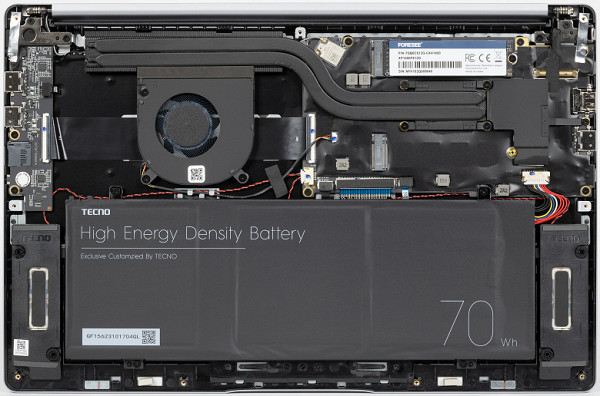
The rest of the interior space is taken up by a three-cell lithium-ion battery. There are speakers on the sides of the battery.
RAM and wireless communication module are soldered.

The laptop has two M.2 slots, one of which is already occupied by a standard 2280 NVMe SSD. The second slot is available for adding another SSD of the same form factor, which makes the upgrade options wider than usual in similar laptops. While RAM expansion is not possible, the ability to add a second drive provides additional options for custom upgrades.
The cooling system includes a radiator with one fan, which is connected by a pair of heat pipes to the processor heat sink. Air is sucked in through slots in the bottom and blown back toward the bottom of the screen, as mentioned.

To assess how the operating parameters of system components (temperature, frequency, etc.) change under different load scenarios, we will provide a table that shows the maximum/steady-state values separated by a fraction. The fan automatically adjusts its speed according to need, but its rotation speed is not displayed in the utilities we use.
| Load scenario | CPU frequencies, GHz | CPU temperature, °C | CPU consumption, W | GPU frequency, GHz | GPU temperature, °C | GPU consumption, W |
|---|---|---|---|---|---|---|
| Inaction | 34-37 | 1.0-1.2 | ||||
| Maximum CPU Load | 1.9-2.0 | up to 60 | 15.5-16.5 | |||
| Maximum load on the video card | up to 72 | 18-19 | 2.0 | up to 55 | ≈15 | |
| Maximum load on processor and video card | 1.4 | up to 75 | 29.5/15 | 2.0/0.2-0.4 | up to 65 | 28/11 |
When the processor is loaded (using the powerMax program), the core frequency and consumption remain virtually unchanged: about 1.9-2.0 GHz and 15.5-16.5 W, respectively. The temperature quickly reaches 56-57 degrees, but as the fan speed increases, its growth almost stops, even after 15 minutes the heating does not exceed 60 °C.
The fan operates at low speed, with minimal noise.

At maximum load on the processor and video card, the situation with the processor is very similar, with the exception of some differences: the frequencies are slightly lower, reaching up to 1.4 GHz. Total power consumption briefly rises to almost 30 W and then drops to 25 W. As for the video core, its frequency first increases to 2.0 GHz, but then decreases, fluctuating around 1.6 GHz.
The temperature reaches 75 degrees, and the fan starts to work faster, creating noticeable noise, but not too much.
However, after a minute and a half, the video card experiences another, slower but significant drop in frequency, to 200-400 MHz. The total power consumption is reduced to 15 W, the temperature is also reduced by about 10 degrees, and the fan slows down.
The processor frequency remains stable at 1.4 GHz, so turbo mode is activated only for the GPU. This two-stage reduction in frequency and power consumption is also observed in other laptops with AMD processors, but the final frequency reduction in these models is usually not so significant.

When loaded only on the GPU, the core runs stably for a long time at a frequency of 2.0 GHz, which corresponds to the specification. The temperature gradually rises to 55 degrees, and power consumption constantly varies from 8 to 16 watts, with occasional short peaks of up to 27 watts, with a total consumption of 17-18 watts and temperatures up to 72 degrees. Only after 7 minutes the video core frequency decreases slightly and fluctuates in the range of 1.7-1.9 GHz, which leads to a slight decrease in energy consumption and temperature (this area did not fit on the graphs).
The fan runs at low speed.
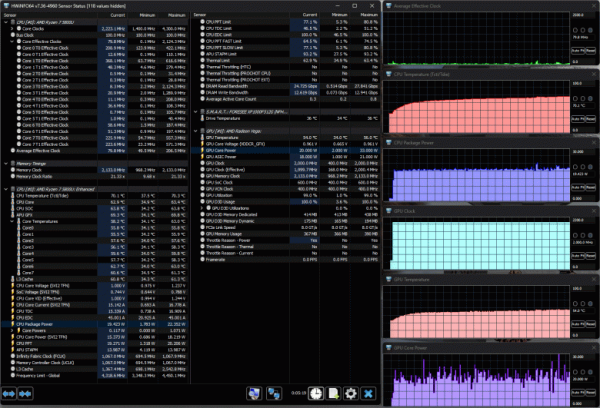
Thus, the cooling system successfully performs its functions, preventing both overheating and throttling, while the processor operates within the TDP stated in the specification.
Below are thermal images obtained after running the laptop for a long time under maximum CPU load:

Above
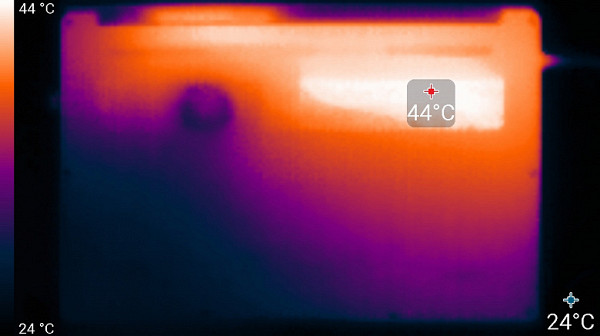
From below

power unit
At maximum load, using the keyboard is quite comfortable: the heating is barely noticeable only under the left wrist, and practically absent at all under the right. However, holding the laptop on your lap can be uncomfortable due to the significant heating of the bottom, especially the left side, while the right side remains relatively cool. The power supply gets very hot, so during prolonged use at high performance it is recommended to ensure that it is not obscured by anything.
Noise level
We measure the noise level in a specially prepared chamber with sound insulation and semi-muffling. The microphone of the sound level meter is positioned in such a way as to imitate the position of the user's head: the laptop screen is tilted back 45 degrees, the axis of the microphone is directed from the center of the screen, the front end of the microphone is at a distance of 50 cm from the plane of the screen, and the microphone is directed towards the screen. The load is created by the powerMax program, the screen brightness is set to maximum. The room temperature is maintained at 24 degrees, but the laptop is not specifically cooled, so the air temperature in the immediate vicinity may be higher. To estimate real consumption, network consumption for some modes is also given. The battery is charged to 100% before taking measurements.
| Load scenario | Noise level, dBA | Subjective assessment | Mains consumption, W |
|---|---|---|---|
| Inaction | 16.2 (background) | conditionally silent | 9 |
| Maximum CPU Load | 26.1 | quiet | 29 (max 33) |
We measure the noise level in a specially prepared chamber with sound insulation and semi-muffling. The microphone of the sound level meter is positioned in such a way as to imitate the position of the user's head: the laptop screen is tilted back 45 degrees, the axis of the microphone is directed from the center of the screen, the front end of the microphone is at a distance of 50 cm from the plane of the screen, and the microphone is directed towards the screen. The load is created by the powerMax program, the screen brightness is set to maximum. The room temperature is maintained at 24 degrees, but the laptop is not specifically cooled, so the air temperature in the immediate vicinity may be higher. To estimate real consumption, network consumption for some modes is also given. The battery is charged to 100% before taking measurements.
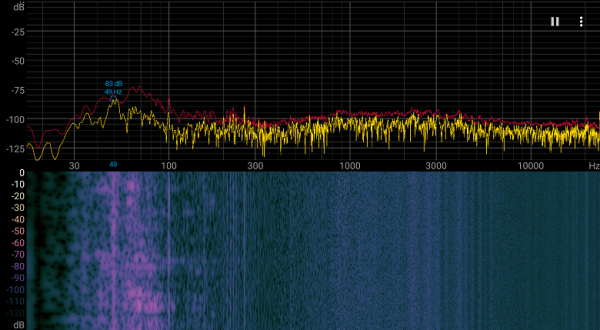
To subjectively assess the noise level, we use the following scale:
| Noise level, dBA | Subjective assessment |
|---|---|
| Less than 20 | conditionally silent |
| 20-25 | very quiet |
| 25-30 | quiet |
| 30—35 | clearly audible |
| 35—40 | noisy |
| 40—45 | very noisy |
| 45—50 | loud |
| Above 50 | very loud |
Measuring the noise level of a computer allows you to determine its sound efficiency. Conventionally, noise levels can be classified as follows:
- Below 20 dBA: The computer is considered virtually silent.
- 20-25 dBA: the laptop can be called very quiet; the noise of its cooling system will not stand out against the background of the usual sounds of an office or home.
- 25-30 dBA: the noise will be noticeable, but not too intrusive.
- 30-35 dBA: The sound is clearly audible and may interfere with long-term operation.
- 35-40 dBA: the laptop is quite noisy, which may require the use of background music to mask it.
- 40-45 dBA: the noise level becomes very high and uncomfortable for work.
- 45 dBA or higher: Requires the use of headphones to reduce noise exposure.
This scale is, of course, relative and may vary depending on the individual preferences of the user and the nature of the background sound in a particular environment.

So, the Tecno Megabook T15DA laptop manifests itself as very quiet in general operating mode, which is confirmed by our subjective impressions.
However, in some modes, even when there is no significant load, the laptop can make a high-frequency whistling sound — although it is not loud, it is quite audible in a quiet room. We do not know whether this is a feature of only our specimen or whether it is a characteristic of all similar devices, since we only dealt with one specimen.
Performance
The laptop has an AMD Ryzen 7 5800U processor with Cezanne-U (Zen 3) architecture, released starting in 2021. It is equipped with 8 cores capable of processing 16 threads. The base frequency is 1.9 GHz, and Precision Boost technology can theoretically overclock some cores (but not all at the same time) to 4.4 GHz, but in our case we did not observe such values.
The base TDP is 15W, but can be adjusted from 10 to 25W. In our previous tests, long-term consumption did not exceed 19 W, which is consistent with these parameters. Peak values could reach up to 30 W.
The processor has an integrated video core, which is used by the laptop — there is no discrete video card. It operates at frequencies up to 2000 MHz, TGP 15 W.
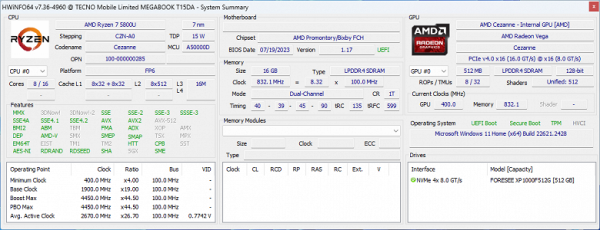
The motherboard contains LPDDR4-4266 memory chips manufactured by SK Hynix, operating in dual-channel mode.
Foresee XP1000F512G drive installed (512 GB, M.2 2280, NVMe, PCIe 3.0 x4):
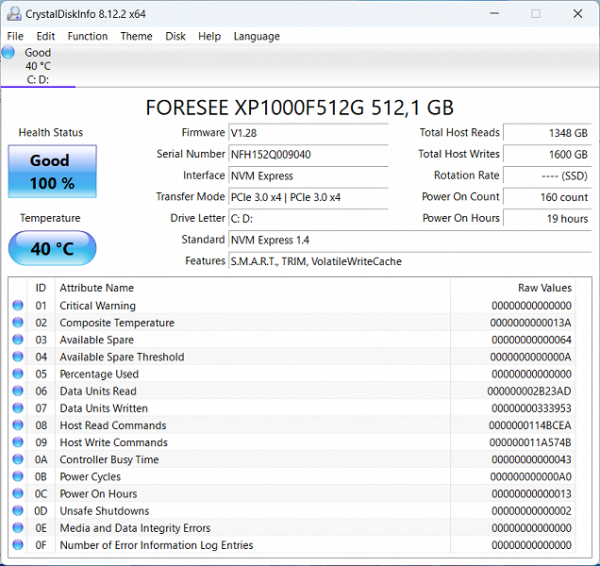
It showed good performance in CrystalDiskMark tests.

We suggest comparing with the test results of two more PCIe 3.0 x4 SSDs — Foresee GSYAPGC-512G (512 GB, Infinix Inbook X2 XL21 laptop) and KingSpec NX-512 (512 GB, Irbis SmartBook 15NBP3508):
For clarity, we present the results in the form of diagrams:


The laptop is equipped with a slot for microSD memory cards. Transfer speeds are measured using a SanDisk Ultra 64GB Class I memory card. Below are the results of testing in the CrystalDiskMark program, as well as for comparison the results of other laptops such as the Tecno Megabook T14TA and Digma Pro Sprint M:
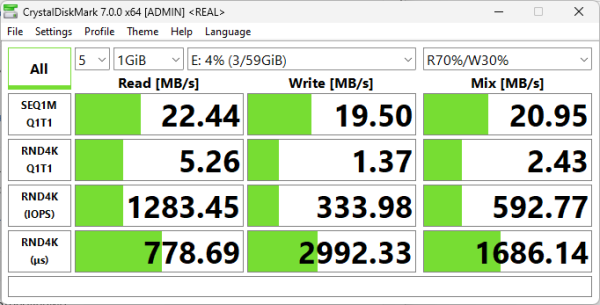
The second test is to measure the speed of real file operations performed using the operating system. In this test, we copied 100 image files totaling 2.5GB, first from the media to a folder on the desktop, and then from the folder to the media.
In the first case, the procedure took 131 seconds, which corresponds to an average speed of 19.1 MB/s, in the second — 144 seconds (17.4 MB/s). For comparison: in a test with the same set of files, the card reader speed of the Tecno Megabook T15DA was average, the Tecno Megabook T14TA was a little faster in one direction and much slower in the other, and the Digma Pro Sprint M was faster in both directions .

We will compare with other Tecno models: Megabook T15AA with Intel Core i5-12450H processor (4+4 cores/12 threads, up to 3.3/4.4 GHz, 35-95 W), 16 GB LPDDR4-4266 RAM and Foresee SSD XP1000F512G PCIe 3.0 x4, Megabook T14TA with Intel Core i5-1155G7 (4 cores/8 threads, 2.5/4.5 GHz, 12-28 W), 16 GB LPDDR4-4266 RAM and the same drive, and Megabook S1 with Intel Core i7-1260P (4+8 cores/16 threads, up to 3.7/5.0 GHz, 20-64 W), RAM 16 GB LPDDR5, SSD Foresee FSb0C001T-C6C7200 PCIe 4.0 x4.
In addition, we include an Irbis SmartBook 15NBP3508 laptop with an Intel Core i5-1235U processor (2+8 cores/12 threads, up to 3.3/4.4 GHz, 12-55 W), 16 GB DDR4-3200 RAM (one module), SSD KingSpec NX-512 PCIe 3.0 x4.
| Reference result (Core i5-9600K) | Tecno Megabook T15DA (AMD Ryzen 7 5800U) | Tecno Megabook T15AA (Intel Core i5-12450H) | Tecno Megabook T14TA (Intel Core i5-1155G7) | Irbis SmartBook 15NBP3508 (Intel Core i5-1235U) | Tecno Megabook S1 (Intel Core i7-1260P) | |
|---|---|---|---|---|---|---|
| Video conversion, points | 100 | 119 | 100 | 73 | 77 | 105 |
| MediaCoder x64 0.8.57, c | 132.0 | 103.5 | 126.9 | 179.8 | 157.8 | 124 |
| HandBrake 1.2.2, c | 157.4 | 130.9 | 163.0 | 216.4 | 228.9 | 149 |
| VidCoder 4.36, c | 385.9 | 350.3 | 392.1 | 527.8 | 488.4 | 376 |
| Rendering, points | 100 | 135 | 111 | 79 | 83 | 124 |
| POV-Ray 3.7, with | 98.9 | 78.5 | 93.4 | 151.4 | 114.9 | 80 |
| Cinebench R20 | 122.2 | 85.1 | 107.0 | 149.5 | 135.6 | 93 |
| Blender 2.79, with | 152.4 | 115.6 | 147.6 | 197.7 | 192.3 | 138 |
| Adobe Photoshop CC 2019 (3D rendering), c | 150.3 | 109.3 | 124.9 | 155.7 | 191.6 | 114 |
| Video content creation, points | 100 | 114 | 120 | 93 | 77 | 134 |
| Magix Vegas Pro 16.0, c | 363.5 | 334.0 | 278.3 | 371.3 | 466.7 | 209 |
| Adobe After Effects CC 2019 v 16.0.1, with | 468.7 | 379.3 | 388.0 | 555.7 | 554.0 | 355 |
| Photodex ProShow Producer 9.0.3782, c | 191.1 | — | 176.9 | 195.2 | 271.6 | 182 |
| Digital photo processing, points | 100 | 110 | 152 | 128 | 78 | 130 |
| Adobe Photoshop CC 2019, s | 864.5 | 831.5 | 641.9 | 743.6 | 923.9 | 645 |
| Adobe Photoshop Lightroom Classic CC 2019 v16.0.1, c | 138.5 | 120.2 | 80.4 | 97.7 | 183.8 | 104 |
| Phase One Capture One Pro 12.0, c | 254.2 | — | — | — | 380.5 | 204 |
| Text recognition, points | 100 | 150 | 119 | 87 | 94 | 132 |
| Abbyy FineReader 14 Enterprise, c | 492.0 | 328.9 | 413.3 | 567.8 | 523.9 | 374 |
| Archiving, points | 100 | 128 | 125 | 104 | 72 | 133 |
| WinRAR 5.71 (64-bit), c | 472.3 | 361.5 | 354.1 | 413.4 | 665.6 | 385 |
| 7-Zip 19, c | 389.3 | 311.2 | 330.0 | 415.5 | 527.2 | 268 |
| Scientific calculations, points | 100 | 111 | 107 | 80 | 70 | 113 |
| LAMMPS 64-bit, c | 151.5 | 121.0 | 148.1 | 182.2 | 195.2 | 137 |
| NAMD 2.11, with | 167.4 | 144.5 | 162.5 | 234.8 | 337.2 | 141 |
| Mathworks Matlab R2018b, c | 71.1 | 72.7 | 69.4 | 94.5 | 93.0 | 65 |
| Dassault SolidWorks Premium Edition 2018 SP05 with Flow Simulation 2018, c | 130.0 | 121.0 | 105.7 | 145.0 | 161.3 | 114 |
| Integral result excluding storage, points | 100 | 123 | 118 | 90 | 79 | 124 |
| WinRAR 5.71 (Store), c | 78.0 | 26.2 | 24.4 | 24.3 | 33.6 | 29 |
| Data copying speed, s | 42.6 | 10.1 | 9.5 | 9.6 | 14.9 | 6 |
| Integral result of the accumulator, points | 100 | 354 | 379 | 378 | 258 | 446 |
| Integral performance result, points | 100 | 169 | 167 | 139 | 112 | 182 |
So, the laptop in question is significantly superior to the Tecno Megabook T14TA and T15AA models in almost all application categories, with the exception of photo processing. The Irbis laptop, equipped with a 12th generation Intel processor, but one of the lower ones in the line, lags significantly behind, and our rather powerful reference desktop also lost, although not as significantly.
In comparison with the Tecno Megabook S1 with a 12-core Intel Core i7 processor, we see actual parity in terms of all indicators: in some application categories the T15DA is ahead, in others the S1 is ahead, and in others the indicators are almost equal.
The drive performed well in the relevant tests.
Game testing
The Tecno Megabook T15AA laptop, equipped only with an integrated video core, cannot be called a gaming laptop.

According to the methodology for 2024, we will test four games: “Tanks”, a racing simulator, “Shooting” and strategy. These games also ran on other laptops used for comparison in application tests. Here are the results for the Medium quality setting and 1920x1080 resolution — average (minimum in parentheses) frame rates averaged over three measurements:
| Game, medium quality, 1920×1080 | World of Tanks | F1 2018 | Gears 5 | Total War Saga: Troy |
|---|---|---|---|---|
| Tecno Megabook T15DA | 78 (45) | 46 (39) | 25 (21) | 40 (34) |
| Tecno Megabook T15AA | 52 (31) | 37 (31) | 16 (10) | 29 (25) |
| Tecno Megabook S1 | 74 (48) | 60 (48) | 46 (26) | 46 (37) |
| Tecno Megabook T14TA | 65 (40) | 56 (46) | 24 (19) | 39 (32) |
| Irbis SmartBook 15NBP3508 | 43 (29) | 30 (26) | 21 (18) | 24 (20) |
The laptop under review does relatively well with “tanks”, but with other games it’s worse — as, indeed, with the rest of the comparison participants, excluding only the Megabook S1 with the most advanced Intel processor. But, of course, none of them are suitable for the role of a gaming laptop.
Conclusion
The Tecno Megabook T15DA was a positive notebook with excellent performance comparable to the Tecno Megabook S1 with Intel Core i7-1260P processor. The autonomy of the device, although not a record, is close to the best, but charging takes a long time.
The cooling system, although it has only one fan, copes with the task perfectly: even with maximum load on the CPU and GPU, the laptop does not overheat and does not slow down. The heating of the housing surfaces remains either low or moderate, and the operation of the device remains quiet. One should not think that these achievements were achieved at the expense of serious limitations on the processor's capabilities.
The set of interface ports is at the level of average Tecno Megabook models, but with more modern Wi-Fi/Bluetooth wireless interfaces. The absence of a connector and adapter for a wired network is justified by the compact size of the device, and the presence of a microSD card reader will be useful to many users.
The upgrade options for this laptop are wider than those of many similar models: although the memory is soldered, the user can not only replace the SSD, but also add a second one.
The 15.6-inch screen with a resolution of 1920x1080 and a refresh rate of 60 Hz meets the standard for devices in this price segment. The screen brightness is average, automatic adjustment is present, the color balance is acceptable, but the color gamut is wider than sRGB.
The keyboard, like other Tecno models, can cause criticism due to the half-height arrows, but the presence of a number pad, albeit a three-row one, is a plus. However, the backlight automatically turning off after fifteen seconds without the ability to configure causes negative emotions.
The webcam is at the level of more expensive models — 1080p resolution, equipped with a privacy curtain.
Overall, the Tecno Megabook T15DA is a solid and compact device with a 15.6" screen, suitable for daily work both at home and in the office, as well as for mobile use thanks to its durable metal body. Moreover, it looks as good as most analogs and is available at a reasonable price.







